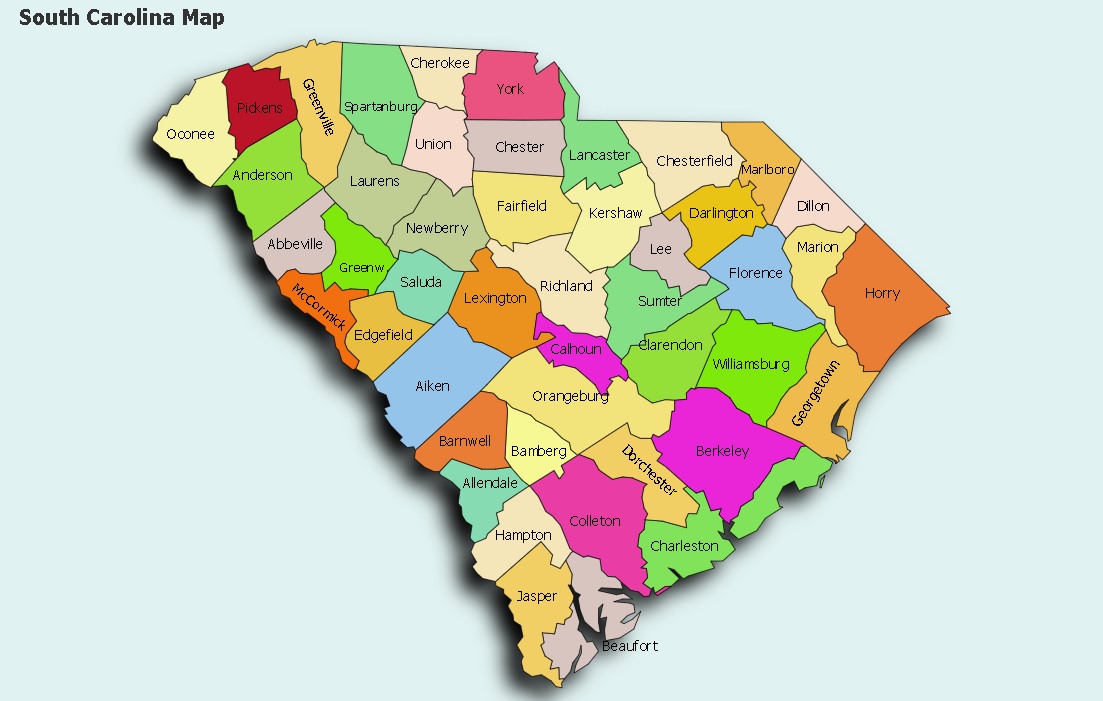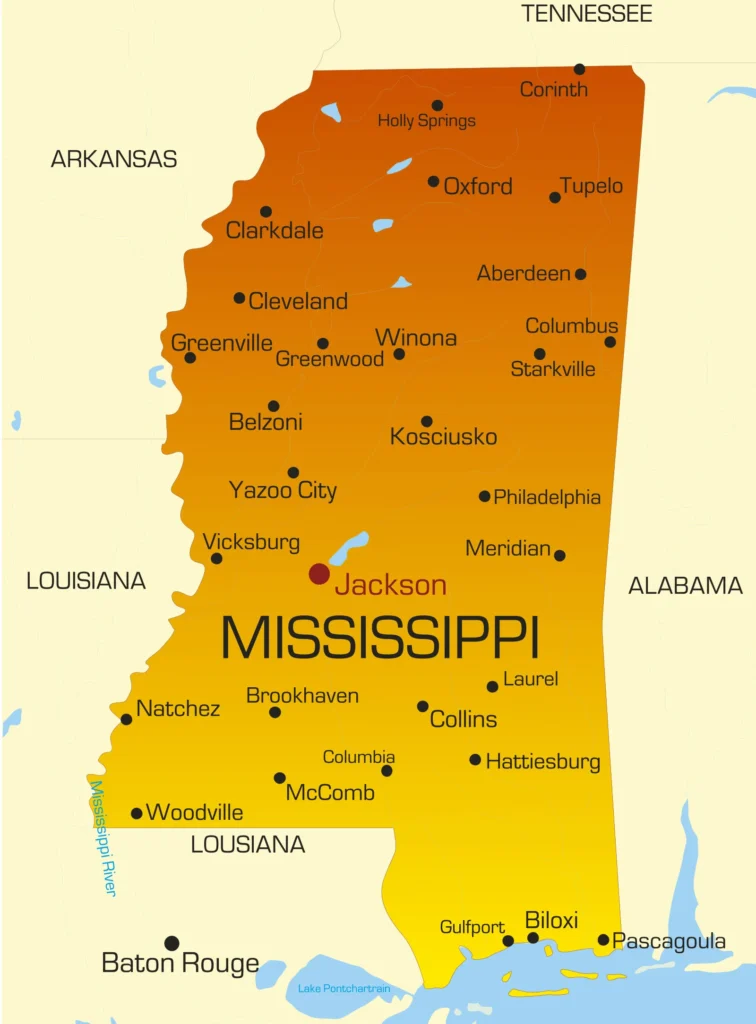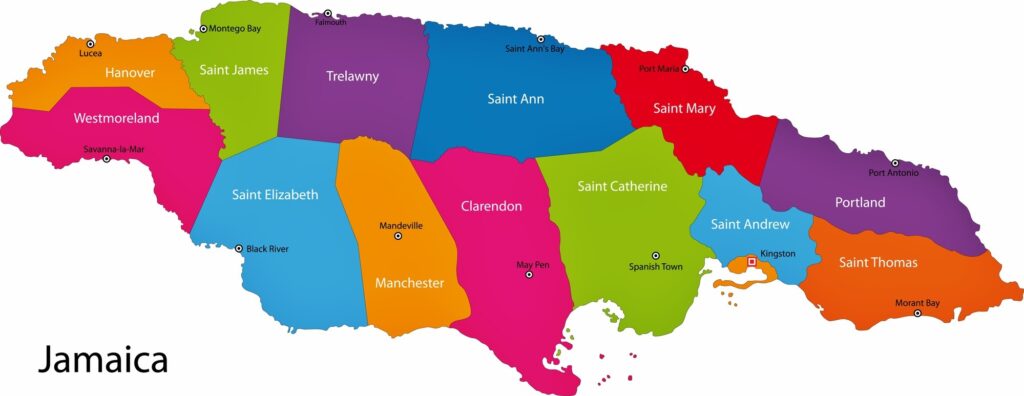Introduction to South Carolina
South Carolina, nicknamed the Palmetto State, is a state located in the southeastern region of the United States. It is bordered by North Carolina to the north, the Atlantic Ocean to the southeast, and Georgia to the southwest. The state is named after King Charles I of England, with “Carolina” being derived from the Latin form of his name.
Geography of South Carolina
South Carolina boasts a diverse landscape, ranging from coastal plains and sandy beaches to rolling hills and mountainous regions.
Coastal Plain
The Coastal Plain, also known as the Lowcountry, is the southeastern part of the state. This region includes the Atlantic coastline, characterized by sandy beaches, marshlands, and barrier islands. Key cities in this area include Charleston, Myrtle Beach, and Hilton Head Island. The coastal plain is known for its subtropical climate, lush vegetation, and abundant wildlife.
Piedmont
The Piedmont region, located in the central part of the state, features rolling hills and fertile valleys. This area is home to major cities such as Columbia (the state capital) and Greenville. The Piedmont is an important agricultural and industrial region, with a mix of urban and rural landscapes.
Blue Ridge Mountains
The Blue Ridge Mountains, a subrange of the Appalachian Mountains, are located in the northwestern corner of South Carolina. This region includes the state’s highest point, Sassafras Mountain, which rises to 3,560 feet. The Blue Ridge Mountains are known for their scenic beauty, outdoor recreational opportunities, and cooler climate compared to the rest of the state.
Historical Overview
South Carolina has a rich and complex history, marked by significant events and cultural developments.
Early History and Colonial Period
The area now known as South Carolina was originally inhabited by various Native American tribes, including the Catawba, Cherokee, and Yamasee. European exploration began in the 16th century, with Spanish and French attempts to establish settlements. However, it was the English who successfully colonized the region in the 17th century.
In 1663, King Charles II of England granted the Carolina territory to eight Lords Proprietors. The colony was divided into North and South Carolina in 1712. South Carolina’s economy grew rapidly due to the cultivation of rice, indigo, and later cotton, which relied heavily on enslaved African labor.
Revolutionary War and Statehood
South Carolina played a crucial role in the American Revolution, with significant battles such as the Siege of Charleston and the Battle of Camden. The state was one of the original 13 colonies that declared independence from Britain. On May 23, 1788, South Carolina became the eighth state to ratify the U.S. Constitution.
Civil War and Reconstruction
South Carolina was the first state to secede from the Union on December 20, 1860, leading to the outbreak of the Civil War. The conflict devastated the state’s economy and infrastructure. Following the war, South Carolina underwent Reconstruction, a challenging period marked by social and political upheaval as the state transitioned from slavery to a free labor system.
Modern Era
In the 20th century, South Carolina experienced significant economic and social changes. The Civil Rights Movement of the 1950s and 1960s brought about desegregation and greater equality for African Americans. Today, South Carolina is known for its growing economy, cultural heritage, and tourism industry.
Climate and Weather
South Carolina’s climate varies from the coastal areas to the inland regions, but it is generally classified as humid subtropical.
Coastal Climate
The coastal areas, including cities like Charleston and Myrtle Beach, experience mild winters and hot, humid summers. Average temperatures in the winter range from 40°F to 60°F, while summer temperatures can reach the mid-90s°F. The region is also prone to hurricanes and tropical storms during the Atlantic hurricane season, which runs from June to November.
Inland Climate
Inland areas, including the Piedmont and Blue Ridge regions, experience a slightly more varied climate. Winters can be cooler, with occasional snowfall in the northern parts, especially in the mountains. Summer temperatures are similar to the coastal regions but with slightly lower humidity.
Economy of South Carolina
South Carolina has a diverse and dynamic economy, with key industries including manufacturing, agriculture, tourism, and technology.
Manufacturing
Manufacturing is a major driver of South Carolina’s economy. The state is a hub for the automotive industry, with major facilities operated by companies such as BMW and Volvo. Additionally, aerospace manufacturing, particularly Boeing’s presence in North Charleston, has become increasingly important.
Agriculture
Agriculture remains a vital part of South Carolina’s economy. The state produces a variety of crops, including tobacco, soybeans, cotton, and peaches. South Carolina is also known for its poultry, cattle, and hog farming.
Tourism
Tourism is a significant industry in South Carolina, attracting millions of visitors each year. Popular destinations include the historic city of Charleston, the beaches of Myrtle Beach and Hilton Head Island, and the scenic Blue Ridge Mountains. The state’s rich cultural heritage, outdoor recreational opportunities, and annual events, such as the Spoleto Festival USA, contribute to its appeal as a tourist destination.
Technology and Innovation
South Carolina has been making strides in the technology sector, with a growing number of tech startups and innovation hubs. Cities like Greenville and Charleston have become centers for tech innovation, fostering a vibrant entrepreneurial ecosystem.
Education and Research
South Carolina is home to numerous institutions of higher education and research centers.
Universities
The state boasts several prominent universities, including:
- University of South Carolina (USC) in Columbia: The flagship public university known for its research programs and the South Carolina Gamecocks sports teams.
- Clemson University in Clemson: A major public research university with strong programs in engineering, agriculture, and business.
- College of Charleston in Charleston: One of the oldest universities in the U.S., known for its liberal arts programs and historic campus.
Research Centers
South Carolina is also home to several research centers and institutes, such as the Clemson University International Center for Automotive Research (CU-ICAR) and the Medical University of South Carolina (MUSC) in Charleston. These institutions contribute to advancements in various fields, including automotive engineering, health sciences, and environmental studies.
Cultural Highlights
South Carolina’s culture is a rich blend of traditions, influenced by its diverse population and historical heritage.
Festivals and Events
The state hosts numerous festivals and events throughout the year, celebrating its culture, history, and community. Notable events include:
- Spoleto Festival USA in Charleston: An annual performing arts festival featuring opera, theater, dance, and music performances.
- South Carolina State Fair in Columbia: A long-standing tradition with agricultural exhibits, rides, games, and entertainment.
- Gullah Festival in Beaufort: Celebrates the Gullah culture, highlighting African American heritage, food, and crafts.
Historic Sites and Landmarks
South Carolina is home to many historic sites and landmarks that offer insights into its past. Some notable locations include:
- Fort Sumter National Monument: The site of the first shots fired in the Civil War, located in Charleston Harbor.
- Middleton Place: A historic plantation with beautiful gardens and a museum showcasing life in the 18th and 19th centuries.
- Congaree National Park: A preserved area of old-growth bottomland hardwood forest, offering hiking, kayaking, and wildlife viewing opportunities.
Fun and Interesting Facts
- South Carolina is known as the “Palmetto State” due to the presence of the sabal palmetto tree, which is also featured on the state flag.
- The state dance is the Shag, a popular style of swing dancing that originated in the coastal regions.
- South Carolina is home to the world’s largest ginkgo farm, located in Sumter.
Conclusion
South Carolina is a state rich in history, culture, and natural beauty. From its diverse geography and dynamic economy to its vibrant cultural heritage and historical significance, the Palmetto State offers a wealth of opportunities for exploration and discovery. Whether you’re interested in its storied past, its scenic landscapes, or its thriving communities, South Carolina is a fascinating and multifaceted destination.
Commonly Asked Questions
What are 5 interesting facts about South Carolina?
- South Carolina is home to the nation’s first tea farm, the Charleston Tea Plantation.
- The state is known for its iconic palmetto tree, which played a crucial role in the Revolutionary War.
- South Carolina is the birthplace of barbecue sauce, with distinct regional styles such as mustard-based in the Midlands and vinegar-based in the Lowcountry.
- The state is home to the world’s largest collection of outdoor murals in the town of Lake City.
- South Carolina’s official state dance is the Shag, a popular style of swing dance that originated along the Grand Strand.
What is a geography fact about South Carolina?
South Carolina boasts a diverse geography, including coastal plains, Piedmont hills, and the Blue Ridge Mountains in the northwest corner of the state.
What is South Carolina state known for?
South Carolina is known for its rich history, beautiful beaches, vibrant culture, and Southern hospitality. It is also famous for its barbecue, sweet tea, and historical landmarks.
What is South Carolina surrounded by?
South Carolina is surrounded by North Carolina to the north, Georgia to the southwest, and the Atlantic Ocean to the southeast.
What is South Carolina’s nickname?
South Carolina is often referred to as the “Palmetto State” due to the presence of the sabal palmetto tree, which is featured on the state flag and emblem.
What is the climate in South Carolina?
South Carolina has a humid subtropical climate, characterized by hot, humid summers and mild winters. The coastal areas experience warmer temperatures year-round compared to the inland regions.
Is there snowfall in South Carolina?
Snowfall is rare in most parts of South Carolina, particularly along the coast and in the Lowcountry. However, the Upstate region, including the Blue Ridge Mountains, may occasionally experience snow during the winter months.
What’s the coldest month in South Carolina?
The coldest month in South Carolina is typically January, with average temperatures ranging from the upper 30s°F to the mid-50s°F.
Does South Carolina have mountains?
Yes, South Carolina is home to the Blue Ridge Mountains, a subrange of the Appalachian Mountains, located in the northwest corner of the state.
Is South Carolina red or blue?
South Carolina is traditionally considered a “red” state, meaning it tends to support Republican candidates in presidential elections and has a predominantly conservative-leaning electorate.
- Wyoming Maps & Facts - June 26, 2024
- Oregon Maps & Facts - June 14, 2024
- 10 Largest Cities In Africa - June 8, 2024




